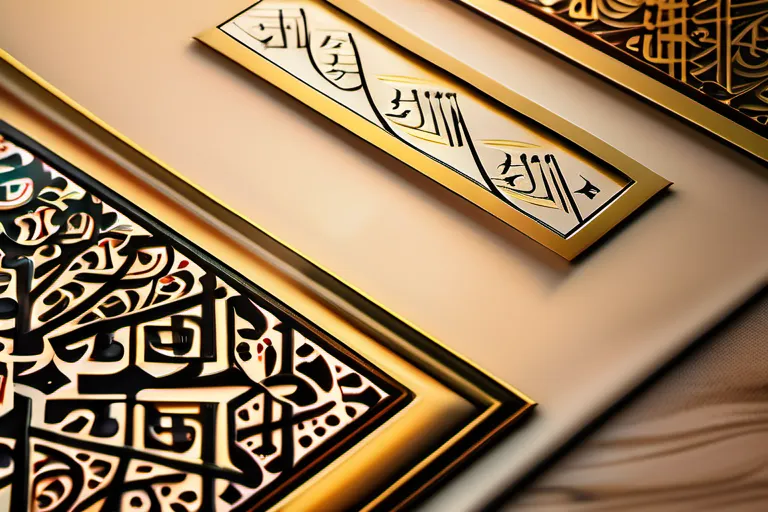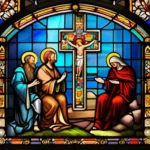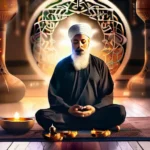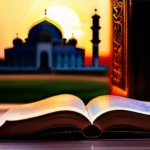Explore the rich history, techniques, and cultural impact of Islamic calligraphy.
Islamic calligraphy is a unique art form that has played an essential role in Islamic culture for centuries. This article delves into the history, techniques, and significance of this beautiful art form.
The Origins and Evolution of Islamic Calligraphy
The origins of Islamic calligraphy trace back to the pre-Islamic Arabian Peninsula, where it was deeply intertwined with poetry and social gatherings. How could this ancient art form have evolved into one of the most revered forms of artistic expression in history? The journey is both fascinating and enlightening.
Imagine a time when qasida, a type of poetic composition, was recited during festivals and religious events. These verses were not just written down but etched with such grace and elegance that they became a form of visual poetry. The early scribes used reed pens made from papyrus or parchment, each stroke telling the story of its era. Could you imagine how these simple tools transformed into the intricately crafted nibs seen today?
During the formative years of Islam, calligraphy took on new significance. With the Hijra, or the migration of Prophet Muhammad from Mecca to Medina in 622 CE, the art began to be closely associated with religious texts and manuscripts. How did this shift impact the way scribes approached their craft? The transition was not just a change in subject matter but also in technique. The Arabic alphabet, now adorned with new styles like Kufic and Thuluth, became a canvas for spiritual expression.
The evolution of calligraphy during this period is akin to the layers of an onion, each layer adding more depth and complexity. From the geometric precision of early scripts to the fluidity and grace of later developments, every style tells a story about its time. How do you think these changes in script reflected the broader cultural and intellectual movements of Islamic civilization?
As the Umayyad and Abbasid caliphates flourished, calligraphy reached new heights. The grand mosques and palaces were adorned with intricate inscriptions, turning every wall into a canvas for divine verses. How did these monumental works influence not only art but also architecture and design? The impact of Islamic calligraphy extended beyond borders, inspiring artists from Spain to India.
The rich history of Islamic calligraphy is a testament to the cultural and spiritual heritage of the Muslim world. It reminds us that every line drawn has a story to tell, every stroke a symbol of devotion and creativity. As we delve deeper into its evolution, we uncover not just an art form but a profound expression of human spirituality and artistic endeavor.
The Role of the Quran and Hadith in Islamic Calligraphy
The Quran, often referred to as the word of God, has been a guiding light for Muslims since its revelation over 1400 years ago. How did this sacred text shape the art of Islamic calligraphy? The answer lies in the meticulous process of copying and preserving the Quranic verses through centuries, transforming simple scripts into intricate works of art.
The earliest manuscripts of the Quran were penned by scribes who treated their work with utmost reverence. Each stroke was deliberate, each curve a reflection of profound devotion. The question arises: How did these early scribes ensure that every letter was not just correct but aesthetically pleasing? It was through the adherence to the rules of stylization and the use of stylized scripts like Kufic and Thuluth. These scripts, with their angular and flowing forms, became a visual representation of the divine word, making each page a sacred space.
The Hadith, or sayings of Prophet Muhammad (peace be upon him), also played a crucial role in shaping Islamic calligraphy. The Hadith, which provide guidance on various aspects of life and worship, were often copied alongside the Quranic text to create composite manuscripts. These works not only served as religious texts but also as decorative art pieces, with intricate borders and ornamental scripts that added layers of beauty and complexity.
The cultural impact of these early manuscripts cannot be overstated. They inspired generations of calligraphers who sought to innovate while maintaining the sanctity of their work. The development from Kufic to more fluid styles like Naskh and Diwani reflects both a technical advancement and a spiritual evolution in the art form.
As we delve into the rich history of Islamic calligraphy, it becomes clear that the Quran and Hadith have not just guided its creation but have also imbued it with a profound sense of purpose. Each stroke, each curve, is a testament to the belief that beauty and piety are inseparable in the art of writing.
The Six Styles of Islamic Calligraphy
The Six Styles of Islamic Calligraphy: Delve into the six main styles, each like a unique voice singing in harmony. The Thuluth script, for instance, is a majestic giant, standing tall and proud—its sweeping curves and elegant proportions evoking grandeur and strength. Can you imagine this style being used to adorn the walls of a mosque or the pages of a Quran? It’s as if each letter is a warrior, ready to defend the sacred verses.
Then there’s the Naskh script, which is more like a gentle whisper—sleek and fluid, yet precise. Imagine using this style for everyday texts such as books or legal documents. Its simplicity and clarity make it perfect for readability. How can one miss the charm of its neat arrangement and the ease with which it flows?
The Diwani script is like a wild dance, twisting and turning in intricate patterns. It’s often used for decorative purposes, adorning gifts or calligraphy pieces meant to be cherished. Could you imagine how mesmerizing these designs are when they fill a page? The complexity of its forms and the skill required to master it make it a true masterpiece.
The Ruq’ah script is almost like a friendly conversation—simple yet effective, with easy-to-read curves and loops. Think about using this for correspondence or personal notes. Its simplicity doesn’t mean it lacks elegance; it’s just that its beauty lies in its straightforwardness. How does the ruq’ah script make you feel when you read or write with it?
The Kufic script is more of a bold declaration—its straight and angular forms making a strong statement. Historically, this style was often used for inscriptions on buildings and monuments due to its clarity and durability. It’s as if each letter is shouting out the importance of the message it carries. How does it make you feel when you see or write in Kufic script?
Lastly, the Muhaqqaq script is like a balanced symphony—its flowing yet structured lines creating a harmonious look. This style often combines the elegance of Thuluth with the clarity of Naskh. It’s perfect for texts that require both beauty and readability. How does it enhance the text when used in calligraphy?
Techniques and Tools Used in Islamic Calligraphy
When we talk about Islamic calligraphy, it’s like discussing the brushstrokes that paint the very essence of Arabic script. But how do these intricate and ornate designs come to life? What tools and techniques are used to create such masterpieces?
The first thing that comes to mind is the pen. Yes, a pen, but not just any pen. Calligraphers use a special type of pen called a qalam, which can be made from reed or bamboo. This tool requires great skill and precision; imagine trying to write with a feather dipped in ink—each stroke must be controlled and measured.
The choice of ink is equally important. Calligraphers often use dur, which is made from gallnuts and water, giving it a deep, rich color. Other types of ink might contain ingredients like soot or minerals to achieve different shades. The color itself becomes almost an extension of the message being conveyed—like choosing the perfect shade of blue for a calm seascape.
But what about paper? Calligraphers carefully select their paper, preferring materials that can hold up well under repeated use and layers of ink. Traditional papers are often handmade from cotton or linen fibers, providing a smooth surface that allows the pen to glide effortlessly across it. It’s like preparing a canvas for a masterpiece; each sheet must be flawless.
Adding to this, calligraphers often employ perspective and composition. They arrange their letters in ways that enhance readability while also adding aesthetic value. Think of it as arranging flowers in a vase—every petal has its place, just like every letter in a calligraphy piece.
The tools and techniques used in Islamic calligraphy are more than just methods; they’re a language of artistry and devotion. Each stroke tells a story, each design carries meaning. Through these elements, calligraphers transform simple scripts into something profound, bridging the gap between text and beauty.
The Cultural Impact of Islamic Calligraphy
Imagine walking through a bustling bazaar, where the air is thick with the scent of spices and the sounds of haggling merchants. Suddenly, your eyes are drawn to a small shop adorned with intricate patterns that seem to shimmer in the light. You step inside and find yourself surrounded by calligraphic art, each piece telling a story through its elegant curves and flowing lines. How does such an ancient form of artistic expression continue to influence global cultures?
Islamic calligraphy has left an indelible mark on architecture, fashion, and even technology. Consider the al-jali script adorning the walls of mosques around the world. Its grandeur not only serves as a reminder of divine presence but also as a visual aid in guiding worshippers towards the center of prayer. These intricate designs are more than just decorative; they are gateways to spiritual contemplation.
In fashion, designers have incorporated calligraphic elements into their work, creating stunning garments that blend tradition with modernity. From abayas adorned with Arabic script in vibrant colors to jilbab dresses featuring delicate calligraphic patterns, these pieces not only showcase the beauty of traditional art but also serve as a statement of cultural pride.
The spread of Islamic teachings through calligraphy has been nothing short of remarkable. The verses from the Quran have traveled across continents and cultures, inscribed on manuscripts, walls, and even digital platforms. These words, conveyed in elegant scripts like thuluth, have inspired millions to reflect on their faith and seek knowledge.
Even today, Islamic calligraphy continues to evolve, integrating itself into the modern world. From graffiti artists using calligraphic techniques to express social justice issues to tech companies developing apps that allow users to learn and practice calligraphy, this art form remains as vibrant and relevant as ever. It serves not only as a means of artistic expression but also as a powerful tool for spreading ilham, or divine inspiration.
As we explore the cultural impact of Islamic calligraphy, one can’t help but marvel at its enduring influence. From the sacred to the secular, from tradition to innovation, this art form continues to captivate and inspire, reminding us that beauty and wisdom often come hand in hand.
Modern Trends and Innovations in Islamic Calligraphy
How has Islamic calligraphy evolved in the modern age? The answer lies in its adaptability and resilience, much like a river that carves through rock over time. In today’s digital era, traditional pen and ink have been joined by digital art, opening new horizons for this ancient art form.
Imagine an artist transforming the delicate curves of script into pixels on a screen. The process is as intricate and meticulous as ever, but now the canvas stretches beyond physical limitations. Artists can collaborate globally through online platforms, creating collaborative projects that blend various styles and techniques.
These innovations don’t just change how calligraphy looks; they challenge its very purpose. How does a digital piece of art convey the same spiritual depth as an ink on parchment? The debate rages, but one thing is clear: Islamic calligraphy remains a living, breathing entity that continues to evolve with each generation.
From virtual exhibitions and interactive installations to artistic workshops held in science labs where artists and scientists explore new media, the future of Islamic calligraphy seems more vibrant than ever. Could this fusion lead to breakthroughs that redefine not only art but also our understanding of culture and technology?
The journey from ancient manuscripts to modern screens is a testament to the enduring spirit of Islamic calligraphy. As we navigate these new landscapes, one question remains: How will you contribute to its evolution? Will your brushstroke or pixel add another layer to this timeless art form?
Conclusion
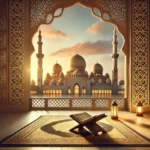 Understanding Islamic calligraphy provides insights into Islamic culture and its deep appreciation for beauty and harmony. It serves as a testament to the enduring influence of Islamic art on global cultures.
Understanding Islamic calligraphy provides insights into Islamic culture and its deep appreciation for beauty and harmony. It serves as a testament to the enduring influence of Islamic art on global cultures.

